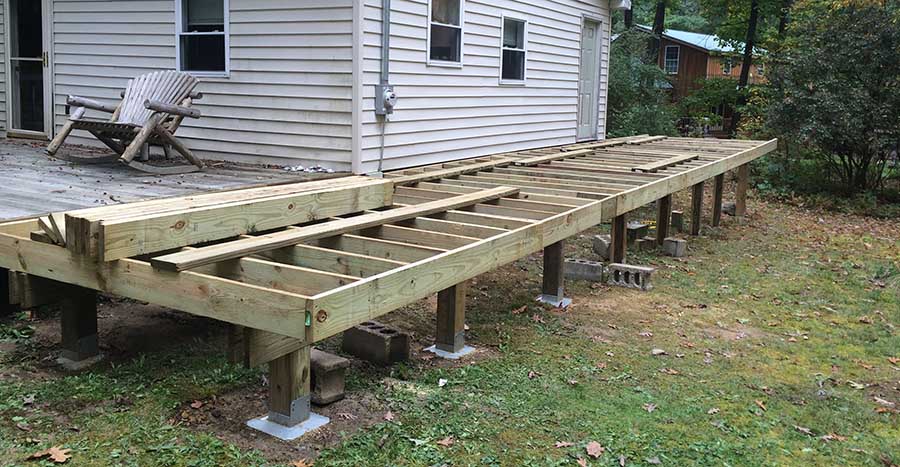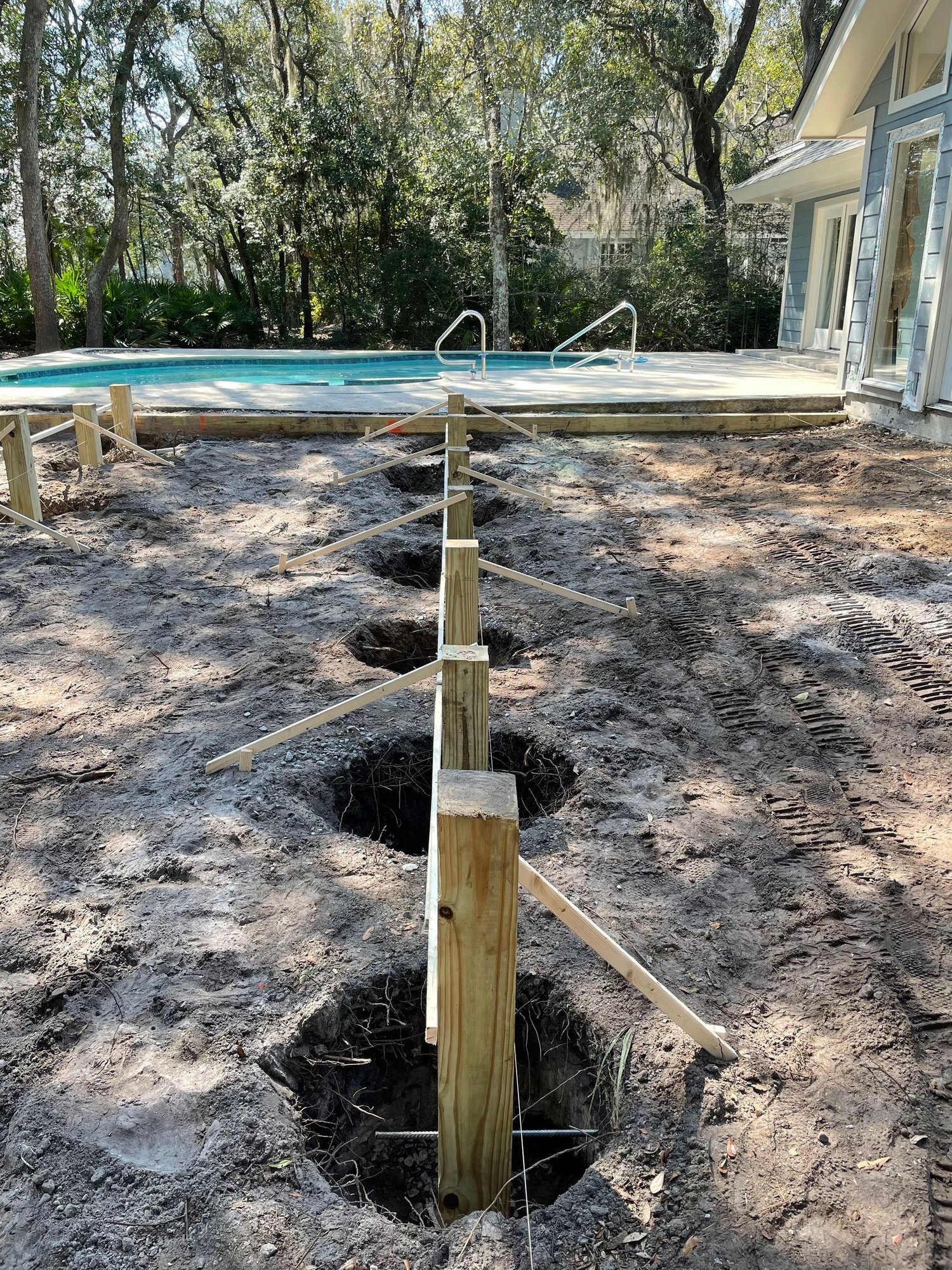Optimize the Lifespan of Your Deck With Solid and trustworthy Grounds
In order to fully make the most of the life expectancy of your deck, it is crucial to guarantee that it is developed on dependable and solid footings. These footings form the structure of your deck, giving security and assistance, and are often the difference in between a deck that lasts for decades and one that needs continuous repair work. In this discussion, we will explore the significance of reputable grounds, the various kinds of solid footing materials, proper installation techniques, and exactly how to preserve and examine your deck's footings to prevent damage.
Relevance of Trustworthy Footings
The value of trustworthy footings can not be overemphasized when it concerns taking full advantage of the lifespan of your deck. The grounds work as the structure whereupon the whole framework relaxes, supplying stability and support. Without a solid footing, the deck is vulnerable to moving, sinking, and also collapse, which can considerably reduce its lifespan and position safety risks.

Picking the best kind of footing is also vital. One of the most common types include concrete footings, helical piers, and sonotubes. Factors such as soil conditions, environment, and the dimension of the deck will certainly determine one of the most appropriate alternative. Hiring an expert to analyze the dirt, design the grounds, and ensure correct installation is highly recommended.
Spending in reliable footings might include extra price and effort upfront, yet it is a rewarding financial investment that will certainly add to the long-lasting longevity and safety of your deck. By guaranteeing a strong structure, you can appreciate your deck for lots of years to find, knowing that it is built to stand up to the test of time.
Types of Solid Ground Materials
To ensure the security and longevity of your deck, it is necessary to think about the various kinds of solid footing products offered. The choice of footing material is essential as it provides the essential support and stability to hold up against the weight and tons of the deck structure.
One typical and reputable product used for deck grounds is concrete. Concrete grounds are resilient and provide superb stability. They can be put directly into the ground or utilize precast concrete grounds for much easier installation. An additional option is helical piers, which are steel shafts with helical plates that are screwed right into the ground. These piers supply superb load-bearing capability and can be used in numerous soil problems.
For areas with poor dirt problems, such as expansive or loosened soils, a footing system that uses steel or composite piers might be favored. Deck Footings. These piers are driven deep right into the ground to reach steady dirt layers, making sure the security of the deck
In some cases, deck footings can additionally be constructed using treated lumber. It is crucial to ensure that the lumber is correctly dealt with to resist rot and degeneration created by direct exposure to dampness and insects.
When choosing a footing material for your deck, it is vital to think about variables such as dirt problems, environment, and neighborhood building regulations. Consulting with a professional contractor or architectural designer can help determine the most suitable footing material for your specific deck project.
Appropriate Installment Strategies for Grounds
Taking into consideration the relevance of ensuring security and durability for your deck, it is essential to understand the proper installation strategies for grounds. The success of your deck job depends heavily on the stability of its structure, which is why adhering to the proper setup methods is important.
Most importantly, it is required to identify the suitable size and deepness of the footings based on the layout and tons demands of your deck. This information can be acquired from developing codes or through appointment with an architectural engineer. As a basic policy, footings need to go to least 12 inches in size and prolong below the frost line to prevent working out or changing.
As soon as the dimensions are developed, the following step is excavation. Digging the openings for the footings need to be performed with precision, seeing to it they are deep sufficient and have a degree bottom. Deck Footings. This will certainly supply a stable base for the grounds
To even more improve the stability of the grounds, it is recommended to make use of a concrete mix with a toughness of at the very least 3,000 psi. This will certainly make sure the grounds can withstand the weight and pressures exerted by the deck.
Throughout installation, it is necessary to maintain the footings degree review and aligned effectively. This can be achieved by making use of a level and string lines to assist the placement of each footing.
Keeping and Examining Your Deck's Grounds
Regular maintenance and thorough assessments are essential for guaranteeing the lasting stability and safety and security of your deck's footings. Gradually, grounds can yield to tear and wear, weather, and dirt activity, which can compromise their structural stability. To optimize the life-span of your deck's footings, it is essential to carry out a normal upkeep routine and carry out detailed evaluations.

In addition, it is important to inspect footings for any kind of signs of damages or wear and tear. This consists of checking for fractures, divides, or crumbling concrete, as well as any kind of signs of motion or negotiation. Any problems need to be dealt with without delay to avoid additional damage and guarantee the security of the deck.
In addition, it is suggested to check the bordering soil for any type of indications of disintegration or shifting. Soil motion can influence the stability of the footings, so it is necessary to address any type of soil-related issues without delay.
Signs of Ground Damage and Just How to Address Them
Footing damages can posture serious dangers to the stability and safety of your deck, making it important to without delay determine and deal with any indications of damage. Among the most common signs of footing damage is working out or sinking of the deck. This can happen because of soil erosion, inadequate footings, or poor construction practices. If you discover that your deck is uneven or leaning, it is essential to take instant action to avoid further damage. One more indication of footing damage is falling apart or cracking of the concrete grounds. This can be triggered by freeze-thaw cycles, extreme moisture, or inadequate top quality concrete. It is important to have them evaluated and fixed by a professional if you observe any kind of fractures or wear and tear in the footings. In addition, if you observe any activity or moving of the deck, such as a deck that feels unpredictable when walked on or totters when weight is applied, maybe an indication of footing damages. In such situations, it is recommended to talk to a structural designer or an expert service provider to analyze the extent of the damages and identify the ideal program of activity. Remember, dealing with footing damages promptly can assist ensure the long-lasting security and security of your deck.
Final Thought
Finally, ensuring the dependability and stamina of grounds is crucial for making best use of the lifespan of your deck. By utilizing solid ground products and appropriately mounting them, you can protect against damage and maintain the stability of your deck. Normal upkeep and additional resources evaluations will additionally assist recognize any type of indications of footing damages and enable for prompt fixings. Inevitably, taking these measures will certainly aid preserve the integrity and long life of your deck.
These footings form the foundation of your deck, giving stability and support, and are often the distinction in sites between a deck that lasts for decades and one that requires consistent repair services. In this discussion, we will check out the value of reputable footings, the various kinds of strong ground products, proper installment techniques, and just how to preserve and examine your deck's grounds to stop damage.Normal maintenance and comprehensive inspections are vital for ensuring the long-lasting stability and security of your deck's grounds. Bear in mind, dealing with footing damage without delay can help ensure the lasting stability and security of your deck.
By using solid ground materials and correctly installing them, you can stop damage and maintain the security of your deck.